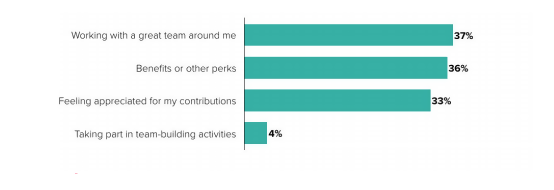Connect with us

Five Essential Statistics on the Power of Collaboration
The current business infrastructure highlights the progress of mankind. We no longer need to be in the same room with other people to collaborate.
People can work from anywhere in the world, given that that place has internet and electricity. Incidentally, nearly four million Americans found their favorite workplace — their own homes.
At the very core of this phenomenon are the gig economy and technological progress. This allows to considerably improve the quality of life for many people, by cutting down the time they spend commuting to work, increasing their productivity, and offering impressive freedom to travel while working.
What’s more interesting is that it has motivated people to collaborate more often and much more efficiently via methodologies, frameworks, and most importantly, collaboration software.
In this article, we’ll look into a list of mind-blowing collaboration statistics. Let’s dive right in, shall we?
1. Collaboration is More Than Lip Service
While many professionals recognize the immense importance that cooperation has to offer, businesses, unfortunately, don’t do enough to stimulate their employees to collaborate.
As a study published by Queens University suggests, the problem with this extensive lack of collaboration is by no means technological, since we have so much cutting-edge software like Troop Messenger that allows organizations to communicate effortlessly.
Employees all too often lack the soft skills needed to bridge the personal and cultural divides between them and their colleagues. Simple things like greeting one another as you go about the working day help to open everyone up and make them more approachable.
Communal breakout spaces allow team members to talk about ideas and proposals in a more inviting environment than the boardroom and are essential for allowing junior members to have a voice.
It’s all about creating an environment in which everyone feels empowered and encouraged to make a difference, provide feedback, and put forward a new idea.
But it’s not just the employee’s fault.
When asked on the importance of collaboration in the workplace, three-quarters of surveyed employers suggested that it’s essential to their company’s output.
However, ironically, under 20% of employers discuss factors like “communication,” when performing regular performance reviews.
“It’s most definitely the case that businesses will benefit greatly from having a dedicated strategy to stimulate collaboration within their organization.”
— Jenna Langley, a Head of HR at Trust My Paper.
The same study also suggests that 39% of employees find that they don’t collaborate enough.
2. Lack of Collaboration Can Fail Projects
A recent study published by Salesforce indicates that little over 85% of respondents consider that the primary reason for failed projects and workplace failures, in general, is an overall lack of collaboration and poor communication.
The same study suggests that a whopping 97% of surveyed workers indicate that the factor that has the most adverse effect on the outcome of work-related projects or tasks is a lack of alignment within teams or coworkers.
This should be another red flag for business owners and executives to start implementing the right strategies and the right software in their company’s workflow, which will allow to considerably optimize the success rate of their projects.
3. A Strong Sense of Community
Besides allowing to considerably improve an organization’s KPIs, the collaboration will enable us to feel like we’re part of something greater than ourselves. Teamwork allows us to have a strong sense of community and belonging.
A report published by Gusto indicates that efficiently working in teams is one of their central motivators of remaining loyal to the business they work for.
More importantly, it’s now very common for people to consider leaving their workplace, because they didn’t feel like they had a strong connection to the collective and that they didn’t collaborate very well.
When surveyed, 52% of respondents said that they did consider leaving a job, because they didn’t have a strong sense of community at their workplace.
Furthermore, the same study indicates that nearly 55% of employees have stayed on a job longer than they intended due to a powerful sentiment of belonging and a strong bond to the community.
When asked what the most important reason for staying at their current company is,

nearly 40% of respondents indicated that it’s due to working with a great team.
4. A Considerable Boost in Performance
A paper published in the Journal of Experimental Social Psychology back in 2014, found that even the illusion of working on a task with a group of people considerably increased the output of the subjects.
The participants were told that they are to work on a task that was a collaborative effort and that many other people are working on a common goal, others were told that they are to work on a task on their own.
The experiment concluded that the participants that were working on a “team project” lasted nearly 65% longer than their solo counterparts. More importantly, they appeared to be less tired and were able to achieve higher success rates.
The researchers that conducted the study suggest that by merely feeling that you are a part of a collective that is working for the common good stimulates people to take on challenges.
A similar study was published by the Institute for Corporate Productivity indicates that organizations that stimulate collaboration among their employees are five times more likely to have a considerable performance edge over businesses that do not.
The authors examined a broad set of companies (over a thousand) that identify as businesses with collaborative cultures.
The same study has highlighted another significant finding — companies that worked for a higher goal, that had a purpose, so to speak, were even more high performing than the companies that just identified as companies with collaborative cultures.
5. Low Morale is Detrimental
The truth is that improper communication won’t just stop your organization from enjoying the benefits of high-quality teamwork — it can considerably decrease employee morale, which, as a result, will dramatically reduce your employee happiness and retention.
In a study published by Accountemps, nearly a third (33%) of human resources officers indicated that improper collaboration and communication are what define low employee morale. The second most common factor that determined the employees’ discontent with their job was excessive micromanagement.
The authors have identified the most important solutions to low employee morale:
- Gossip due to insufficient information. Humans are evolutionarily driven to understand their surroundings. When we lack clear information, our brains need to complement reality with assumptions, rather than facts. Don’t hide important information from the team.
- No initiative. Employees that lack purpose and don’t feel that they are part of a team will often avoid taking the initiative in their hands. Always ensure that your teammates understand the value of their impact on the project.
- Lack of rewards and appreciation. Besides simply indicating how important their input is, employees need to be occasionally rewarded for their hard work.
Being able to identify the above red flags will allow you to address these issues and alleviate the adverse effects in a timely manner before they can escalate. Furthermore, this will enable you to improve your team’s productivity.
Conclusion:
Businesses often forget how much work has to be done after they’ve recruited their personnel. As research suggests, organizations need to invest a lot of time and effort into motivating their workers to collaborate and also create an environment that is conducive and suitable for a fruitful collaboration between employees.
Author Bio
Diana Nadim is a writer and editor who has a Master degree in Marketing. She combines her passion for writing with her interest in research and creates thought-provoking content in various fields. Besides working as a contributor writer for Studicus, Diana also runs her own 3to5Marketing blog. What inspires her the most in her writing is travelling and meeting new people. Follow her on Twitter








